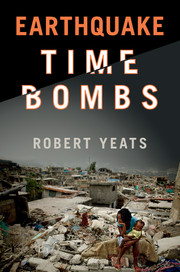28 - Where do we go from here?
from PART III - SUMMARY AND RECOMMENDATIONS
Published online by Cambridge University Press: 05 November 2015
Summary
The study of earthquake time bombs around the world, including examples from the developed world (California, Cascadia, Japan, New Zealand, and Chile), concludes that (1) the outer layer of the Earth consists of moving tectonic plates that generate large, damaging earthquakes on their boundaries as well as within their interiors, (2) earthquake scientists are able to identify most, although not all, of the hazardous faults that are the sources of future earthquakes, (3) the rapid increase in population, particularly in megacities in the developing world, indicates that losses from the next earthquake will be many times larger than previous earthquakes on the same fault, as shown by the Haiti earthquake of 2010, and (4) earthquake scientists are as yet unable to predict the time, place, and magnitude of a future earthquake, even if the statistical probability of an earthquake on its source fault can be estimated.
Because earthquakes cannot yet be predicted, people, even in developed countries, are likely to take chances in their response to the threat of an earthquake. Real-estate developers may point out that the life of their development, a few hundred years, is small compared with the likelihood of the development being struck by an earthquake, a likelihood that may be measured in thousands of years. Homeowners may decide not to buy earthquake insurance, or they may not retrofit their homes and places of employment against earthquake damage. In addition, they will not demand that their state and local governments strengthen lifelines such as utility pipelines or transportation arteries like highway bridges and railroads, as discussed in the chapter on the next Cascadia earthquake.
Society tends to regard the study of earthquakes as academic research rather than a means to strengthen communities and economies against the effects of a large earthquake. Since scientists cannot answer the one question the public really wants to know – “When's the next Big One?” – decision makers gamble that the earthquake will not strike in their lifetimes, or, for political leaders, during their time in office.
Japan is the most prepared country on Earth against earthquakes, but even Japan underestimated the size of the magnitude 9 Tohoku-oki earthquake of 2011, resulting in the loss of nearly 16,000 lives, most from the tsunami that accompanied the earthquake.
- Type
- Chapter
- Information
- Earthquake Time Bombs , pp. 321 - 333Publisher: Cambridge University PressPrint publication year: 2015

